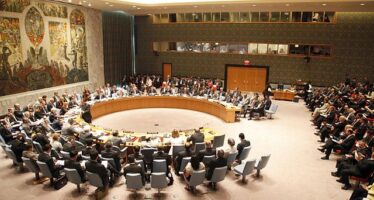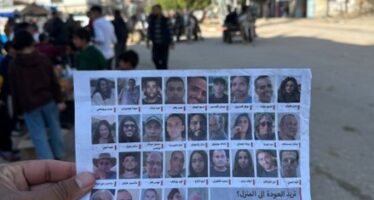Security forces fire on Cairo ‘Nakba’ rally
![]()
Dozens injured as army and police use live ammunition, witnesses say, to disperse demonstration at Israeli embassy
Evan Hill
At least 120 people were injured, one of them critically, when Egyptian security forces attacked a pro-Palestine demonstration outside the Israeli embassy in Cairo on Sunday night, according to witnesses.
Witnesses told Al Jazeera that army and internal security troops used tear gas, rubber-coated bullets and live ammunition to disperse the thousands of protesters who had gathered in the Giza area to mark the 63rd anniversary of the “Nakba” or “catastrophe”.
The Nakba commemorates the day in 1948 that Israel declared its independence and thousands of Palestinians fled or were expelled form their homes.
At least two protesters were shot by live ammunition, while others were hospitalised after inhaling tear gas or being hit by rubber-coated steel bullets, some of which penetrated the skin, witnesses said.
The AP news agency, quoting witnesses, said three people had been killed by gunfire and one shot in the leg, but that report could not be corroborated.
One protester, Atef Yehya, was shot in the head and remained in critical condition on Monday morning, while another, Ali Khalaf, was shot in the abdomen and believed to be stable, witnesses said. As many as 60 people were arrested.
The violence came at around 11pm after a group of protesters surged toward the front of the multi-story office building that contains the Israeli embassy and managed to push aside some of the barriers that had been erected in front of the ground-floor entrance, they said.
Members of the Central Security Forces responded with a heavy volley of tear gas, driving the protesters back with support from military troops on the scene. Witnesses said the army forces – a mix of regular soldiers and military police – first fired in the air to disperse the protesters but then aimed at the crowd.
Protesters responded by burning tires in the street and throwing stones.
“The army was running after us, shooting rubber bullets,” said Sanaa Seif, an activist who attended the protest. “I kept on hearing gunfire from everywhere, and someone told me that there was gunfire from the Central Security Forces … I wasn’t sure if it was rubber or live, people were saying rubber.”
Activist Sanaa Seif shot this video of protester Ali Khalaf, who was reportedly shot in the abdomen
In the chaos, a friend of Seif’s, Youssef Bagato, was shot by a rubber-coated bullet that lodged in his back.
Another protester had fainted nearby, and Seif and her friends helped him into the entrance of a building to recover. There they found Khalaf, suffering from a bullet wound below his stomach.
The group moved Khalaf inside a nearby shop to hide him from security forces but were forced to leave by the owner, who feared they would be found. They moved to a main street and put Khalaf into a cab with his friends to be taken to a hospital.
Yehya, the protester who was shot in the head, was taken to Kasr al-Aini Hospital in central Cairo for treatment, according to Mona Seif, another activist and Sanaa’s sister. He too had been hit during the initial retreat from the security forces.
The bullet penetrated Yehya’s frontal lobe, said Seif, who was in contact with two of Yehya’s friends.
Unclear fate for detainees
Street clashes continued for several hours after security forces first dispersed the crowd. At around 4am, Central Security Force and army troops closed in on the remaining protesters, arresting dozens.
Mohamed Effat, a freelance journalist who was chronicling the protest on Twitter, wrote that the security forces approached from one side and fired tear gas, driving the demonstrators into army troops coming from the other side.
“They pointed their guns at us, forced us to lie on our stomachs, fired heavily into air, cussing at and hitting us. An officer told me whoever looked up would be smacked on the neck,” he wrote. “Last thing was that they took our phones and IDs, queuing us to put in [Central Security] cars while yelling ‘Have fun in military prison rev[olutionary] youth’.”
A protester tells activist Gigi Ibrahim how Atef Yehya was shot in the head
Effat was the only one among those arrested to be released, he said. Others were reportedly taken to an internal security facility in Giza. They included Tarek Shalaby and Mosaab Elshamy, two activists who became well known on Twitter during the revolution.
Shalaby apparently had been using the mobile phone livestreaming service Bambuser during his arrest and left some video and audio of the incident posted online.
Shalaby had returned to Cairo at around 3am after an unsuccessful attempt to join a “Nakba Day” protest at the Rafah border crossing between Egypt and the Gaza Strip.
The army managed to shut down that demonstration, erecting several checkpoints along the road toward Rafah and preventing bus companies from ferrying protesters from Cairo.
There were conflicting reports about whether the protesters would face military or civil justice. Army troops at the scene told protesters that those arrested would be taken to the military prosecutor’s office, Effat wrote.
But Seif, who has organised a campaign against military justice in the wake of Egypt’s revolution, said protesters had been taken to the internal security directorate in Giza and that it appeared they would not be referred to a military court.
Elshamy was being held inside a Central Security Force truck at the security directorate, his brother Abdullah wrote on Twitter after receiving a phone call from Elshamy.
Related Articles
Gaza/Israel: a propósito de la solicitud de México de intervenir en la demanda de Sudáfrica contra Israel ante la Corte Internacional de Justicia
![]()
El pasado 28 de mayo, la Corte Internacional de Justicia (CIJ) anunció, mediante una comunicado de prensa, haber recibido una solicitud formal de intervención de México en el marco de la demanda de Sudáfrica contra Israel
Estados Unidos veta resolución que recomienda a Palestina como Miembro de Naciones Unidas
![]()
Este 18 de abril, Estados Unidos vetó un proyecto de resolución con el de fin de recomendar a la Asamblea General de Naciones Unidas a Palestina como Estado Miembro
“Do you wish to return home”? Letter to Israel of the Zionist Settlers
![]()
“These leaflets were dropped on Gaza’s starving population today. It’s one more clear and cruel way Israel is telling the Palestinians in Gaza that they are being deliberately targeted, starved, and uprooted.”




